The holiday season is a magical time when people from diverse cultures and backgrounds come together to celebrate joy, love, and togetherness. One of the most remarkable aspects of this time of year is the multitude of unique holiday traditions that are cherished and practiced across the globe. From lighting candles in Sweden to celebrating Diwali in India, let’s embark on a journey to discover some of the world’s most fascinating and heartwarming holiday customs.
Section 1: Celebrating Diversity
Las Posadas (Mexico): In Mexico, the “Las Posadas” tradition takes place from December 16th to December 24th. It reenacts Mary and Joseph’s search for a place to stay in Bethlehem. Families, often guided by children dressed as angels, go from house to house, singing carols and requesting shelter. This tradition culminates in a festive party at the final house, complete with delicious Mexican cuisine, pinatas, and sweet treats.
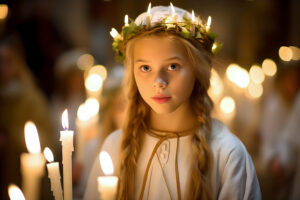 St. Lucia’s Day (Sweden): On December 13th, Sweden celebrates St. Lucia’s Day. A young girl is chosen to portray St. Lucia, wearing a white gown and a crown of candles on her head. She leads a procession of girls, all carrying candles and singing traditional songs. This holiday marks the beginning of the Christmas season in Sweden and is a beautiful way to combat the darkness of winter.
St. Lucia’s Day (Sweden): On December 13th, Sweden celebrates St. Lucia’s Day. A young girl is chosen to portray St. Lucia, wearing a white gown and a crown of candles on her head. She leads a procession of girls, all carrying candles and singing traditional songs. This holiday marks the beginning of the Christmas season in Sweden and is a beautiful way to combat the darkness of winter.
Diwali (India): Diwali, also known as the Festival of Lights, is one of the most significant holidays in India. Celebrated by millions of Hindus, Jains, and Sikhs, it signifies the victory of light over darkness and good over evil. Families decorate their homes with oil lamps and candles, exchange gifts, and enjoy an array of sweets and savory dishes. Fireworks light up the night sky in a dazzling display of color.
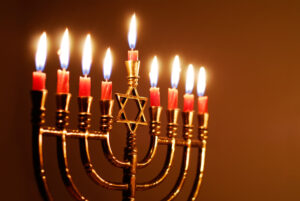 Hanukkah (Israel and Jewish Communities Worldwide): Hanukkah, also called the Festival of Lights, commemorates the miracle of a small amount of oil that lasted eight days in the Holy Temple. Families light a menorah, adding one candle for each night of the eight-day celebration. Traditional foods like latkes (potato pancakes) and sufganiyot (jelly-filled donuts) are enjoyed, along with games like spinning the dreidel.
Hanukkah (Israel and Jewish Communities Worldwide): Hanukkah, also called the Festival of Lights, commemorates the miracle of a small amount of oil that lasted eight days in the Holy Temple. Families light a menorah, adding one candle for each night of the eight-day celebration. Traditional foods like latkes (potato pancakes) and sufganiyot (jelly-filled donuts) are enjoyed, along with games like spinning the dreidel.
Kwanzaa (African Diaspora): Kwanzaa, celebrated from December 26th to January 1st, is a holiday created in the United States to honor African heritage. Each day, a candle is lit on the kinara, a seven-branched candle holder, representing principles such as unity, self-determination, and cooperative economics. Families exchange gifts, share meals, and engage in cultural activities to celebrate their roots.
Simbang Gabi (Philippines): In the Philippines, the holiday season begins as early as September and extends into January. One unique tradition is the Simbang Gabi, a series of nine dawn masses leading up to Christmas. Families come together for these masses and often enjoy traditional Filipino delicacies like bibingka and puto bumbong. The Philippines is also known for its vibrant and elaborate parol lanterns that adorn homes and streets.
Yule (Nordic Countries): Yule is a winter solstice celebration in Nordic countries like Norway and Iceland. It involves lighting a Yule log, a large log often decorated with evergreen branches. The log is burned to bring warmth and light during the darkest time of the year. Feasting and exchanging gifts are also part of the Yule tradition.
St. Nicholas Day (Czech Republic): St. Nicholas Day, celebrated on December 6th, takes on different forms in the Czech Republic and the Netherlands. In the Czech Republic, St. Nick is accompanied by an angel and a devil, determining whether children receive treats or face playful frights. Meanwhile, in the Netherlands, children leave shoes filled with hay or carrots by the fireplace, hoping for small gifts from St. Nick.
Dōngzhì Festival (China): China’s Dōngzhì Festival, a take on the winter solstice, involves paying homage to ancestors and enjoying tangyuan, sticky rice balls in sweet soup. Although no longer a public holiday, many Chinese families continue the tradition, embracing the significance of family and warmth during the winter season.
Section 2: Differing Traditions Around the World
Greece: Christmas Boats – Greece’s maritime tradition takes center stage during the Christmas season as boats adorned with strings of lights grace both waterways and town squares. This tradition, attributed to St. Nicholas being the patron saint of sailors, beautifully merges ancient customs with the festive spirit of the holiday.
Iceland: Thirteen Yule Lads – Iceland brings a touch of mischief to the season with the thirteen troll-like Yule Lads. These mischievous characters leave gifts or, for naughty children, rotten potatoes. The lads, known for their antics like stealing food and slamming doors, add a playful and unique element to Icelandic holiday celebrations.
Israel: Sufganiyot – Hanukkah in Israel is sweetened with sufganiyot, jelly-filled doughnuts enjoyed by Sephardic Jews. The fried treats, symbolizing the miraculous eight days of oil, have become a Hanukkah staple, combining tradition, flavor, and a touch of fried goodness.
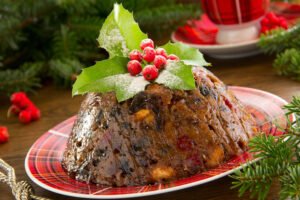 United Kingdom: Christmas Pudding – A beloved British tradition, Christmas pudding, or plum pudding, dates back to the Middle Ages. Evolving from a savory meat-based dish to a fruit-based dessert, the Christmas pudding is soaked in brandy and often hides a coin for good luck, adding a touch of festive excitement to the holiday table.
United Kingdom: Christmas Pudding – A beloved British tradition, Christmas pudding, or plum pudding, dates back to the Middle Ages. Evolving from a savory meat-based dish to a fruit-based dessert, the Christmas pudding is soaked in brandy and often hides a coin for good luck, adding a touch of festive excitement to the holiday table.
Scandinavia: Yule Goat – Scandinavia, particularly Sweden, Norway, and Finland, celebrates the Yule Goat, a variation of the Santa Claus legend. The towns, including Gävle, Sweden, even erect larger-than-life straw goats, symbolizing the spirit of the season. Despite the annual sabotage attempts, the Yule Goat remains a cherished holiday tradition.
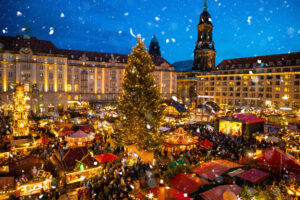 Germany: Christmas Markets – The tradition of Christmas markets originated in medieval Germany, with Dresden hosting the oldest market, Striezelmarkt. These festive markets, adorned with ice skating rinks and towering Christmas trees, offer a magical atmosphere where visitors can revel in the holiday spirit and find unique gifts.
Germany: Christmas Markets – The tradition of Christmas markets originated in medieval Germany, with Dresden hosting the oldest market, Striezelmarkt. These festive markets, adorned with ice skating rinks and towering Christmas trees, offer a magical atmosphere where visitors can revel in the holiday spirit and find unique gifts.
Japan: KFC Christmas – In Japan, Christmas dinners are often incomplete without an unexpected guest: Colonel Sanders from KFC. In the early 1970s, a marketing genius at the first KFC in Japan introduced a “party barrel” of fried chicken for Christmas, inspired by foreign patrons who missed having turkey for the holiday. This clever marketing ploy quickly caught on, and now millions of Japanese families celebrate Christmas with KFC, making it an unexpected holiday tradition.
Egypt: Fruitcake’s Ancient Origins – The ubiquitous fruitcake, often associated with the holidays, has its origins in ancient Egypt. While the Egyptians did not celebrate Christmas, they considered fruitcake a must-have food in the afterlife, making it a central part of burial rituals. This enduring tradition has been embraced by cultures worldwide during the holiday season.
Section 3: Ringing the New Year
Scotland: Hogmanay – Hogmanay in Scotland is a New Year’s Eve extravaganza that lasts until January 2nd, combining winter solstice celebrations with elements from the ancient Gaelic holiday of Samhain. Edinburgh hosts the largest Hogmanay, featuring a torchlight procession with fire, drummers, and bagpipers, creating a unique and fiery start to the new year.
Philadelphia: Mummers Parade – The Mummers Parade in Philadelphia, dating back to 1901, is a New Year’s Day tradition featuring costumed performers from various clubs. The Mummers, originally mimes from European plays, have evolved into a day-long parade with categories like string instruments, comics, and elaborate performances, creating a festive and entertaining start to the year.
Spain: Three Kings’ Day – On January 6th, Spain celebrates Three Kings’ Day, marking the visit of the three wise men to the baby Jesus. Massive parades and the traditional roscon de reyes, a sweet ring-shaped pastry, characterize the day. The pastry often contains a hidden plastic figure, granting the finder royal status for the day, adding a regal touch to the festive celebrations.
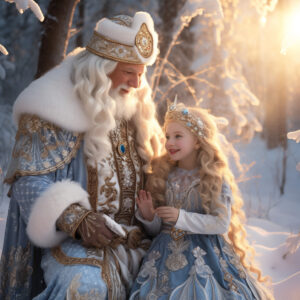 Russia: Ded Moroz – In Russia, Ded Moroz, or Father Frost, takes center stage during the New Year’s Eve celebration. This ancient figure from Slavic mythology, accompanied by his granddaughter Snegurochka, delivers gifts to children. The tradition, stemming from the Bolshevik Revolution’s ban on religious celebrations, adds a distinct Russian touch to the holiday season.
Russia: Ded Moroz – In Russia, Ded Moroz, or Father Frost, takes center stage during the New Year’s Eve celebration. This ancient figure from Slavic mythology, accompanied by his granddaughter Snegurochka, delivers gifts to children. The tradition, stemming from the Bolshevik Revolution’s ban on religious celebrations, adds a distinct Russian touch to the holiday season.
Spain: Twelve Grapes for Twelve Months – In Spain, the transition to the New Year involves a delightful and flavorful ritual. As the clock counts down to midnight, it is customary for Spaniards to eat twelve grapes, one for each stroke of the clock. These twelve grapes symbolize good luck for each month of the upcoming year. In bustling cities like Madrid and Barcelona, the festivities reach a communal level as people gather in main squares, sharing the joy of grape-eating and passing around bottles of cava, the sparkling Spanish wine.
Denmark: Shattering Negativity – In Denmark, the New Year is greeted with a rather cathartic and unconventional practice. As the clock strikes midnight, Danes throw old plates and glasses against the doors of family and friends. This act is believed to banish bad spirits and negative energy, paving the way for a fresh start. Additionally, the Danes engage in the collective activity of standing on chairs and leaping off together, symbolizing a hopeful “leap” into January for good luck.
Finland: Predicting the Future with Molten Tin – Finnish New Year’s celebrations involve a bit of fortune-telling with molten tin. People in Finland cast molten tin into a container of water, and the shape the metal takes after hardening is interpreted as a prediction for the upcoming year. A heart or ring may symbolize a wedding, a ship predicts travel, and a pig signifies an abundance of food.
Brazil: Lucky Underwear – In Brazil, as well as in other Central and South American countries like Ecuador, Bolivia, and Venezuela, wearing special underwear on New Year’s Eve is considered auspicious. Red underwear is believed to attract love in the New Year, while yellow is thought to bring financial prosperity.
Greece: Onions for Rebirth – In Greece, a humble onion takes center stage in New Year’s traditions. On New Year’s Eve, an onion is traditionally hung on the front door of homes, symbolizing rebirth in the coming year. On New Year’s Day, parents wake their children by gently tapping them on the head with the onion, continuing the symbolic theme of renewal and new beginnings.
Conclusion
The holidays, celebrations of hope and togetherness, transcend borders and bring people of all traditions closer. It’s a time when diverse customs, both time-honored and contemporary, shape the way we celebrate and connect with our loved ones. From the vibrant festivities in various corners of the globe to the unique cultural expressions, holidays of all traditions reflect the rich tapestry of human culture and the enduring spirit of generosity and love. As we gather together to celebrate, let us share in the appreciation of the diversity that makes our world so beautifully unique. Happy Holidays to All!


 St. Lucia’s Day (Sweden): On December 13th, Sweden celebrates St. Lucia’s Day. A young girl is chosen to portray St. Lucia, wearing a white gown and a crown of candles on her head. She leads a procession of girls, all carrying candles and singing traditional songs. This holiday marks the beginning of the Christmas season in Sweden and is a beautiful way to combat the darkness of winter.
St. Lucia’s Day (Sweden): On December 13th, Sweden celebrates St. Lucia’s Day. A young girl is chosen to portray St. Lucia, wearing a white gown and a crown of candles on her head. She leads a procession of girls, all carrying candles and singing traditional songs. This holiday marks the beginning of the Christmas season in Sweden and is a beautiful way to combat the darkness of winter. Hanukkah (Israel and Jewish Communities Worldwide): Hanukkah, also called the Festival of Lights, commemorates the miracle of a small amount of oil that lasted eight days in the Holy Temple. Families light a menorah, adding one candle for each night of the eight-day celebration. Traditional foods like latkes (potato pancakes) and sufganiyot (jelly-filled donuts) are enjoyed, along with games like spinning the dreidel.
Hanukkah (Israel and Jewish Communities Worldwide): Hanukkah, also called the Festival of Lights, commemorates the miracle of a small amount of oil that lasted eight days in the Holy Temple. Families light a menorah, adding one candle for each night of the eight-day celebration. Traditional foods like latkes (potato pancakes) and sufganiyot (jelly-filled donuts) are enjoyed, along with games like spinning the dreidel. United Kingdom: Christmas Pudding – A beloved British tradition, Christmas pudding, or plum pudding, dates back to the Middle Ages. Evolving from a savory meat-based dish to a fruit-based dessert, the Christmas pudding is soaked in brandy and often hides a coin for good luck, adding a touch of festive excitement to the holiday table.
United Kingdom: Christmas Pudding – A beloved British tradition, Christmas pudding, or plum pudding, dates back to the Middle Ages. Evolving from a savory meat-based dish to a fruit-based dessert, the Christmas pudding is soaked in brandy and often hides a coin for good luck, adding a touch of festive excitement to the holiday table. Germany: Christmas Markets – The tradition of Christmas markets originated in medieval Germany, with Dresden hosting the oldest market, Striezelmarkt. These festive markets, adorned with ice skating rinks and towering Christmas trees, offer a magical atmosphere where visitors can revel in the holiday spirit and find unique gifts.
Germany: Christmas Markets – The tradition of Christmas markets originated in medieval Germany, with Dresden hosting the oldest market, Striezelmarkt. These festive markets, adorned with ice skating rinks and towering Christmas trees, offer a magical atmosphere where visitors can revel in the holiday spirit and find unique gifts. Russia: Ded Moroz – In Russia, Ded Moroz, or Father Frost, takes center stage during the New Year’s Eve celebration. This ancient figure from Slavic mythology, accompanied by his granddaughter Snegurochka, delivers gifts to children. The tradition, stemming from the Bolshevik Revolution’s ban on religious celebrations, adds a distinct Russian touch to the holiday season.
Russia: Ded Moroz – In Russia, Ded Moroz, or Father Frost, takes center stage during the New Year’s Eve celebration. This ancient figure from Slavic mythology, accompanied by his granddaughter Snegurochka, delivers gifts to children. The tradition, stemming from the Bolshevik Revolution’s ban on religious celebrations, adds a distinct Russian touch to the holiday season.